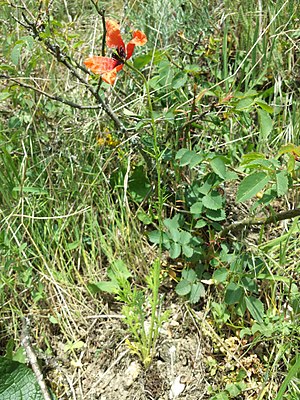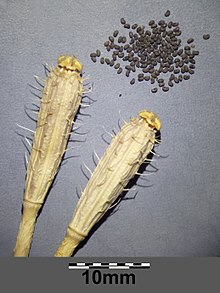Sand poppy
| Sand poppy | ||||||||||||
|---|---|---|---|---|---|---|---|---|---|---|---|---|

Sand poppy ( Papaver argemone ) |
||||||||||||
| Systematics | ||||||||||||
|
||||||||||||
| Scientific name | ||||||||||||
| Papaver argemone | ||||||||||||
| L. |
The sand poppy ( Papaver argemone ) is a plant from the genus poppy ( Papaver ) within the family of Poppy Family (Papaveraceae).
description
The sand poppy grows as a one-year , rarely hibernating, two-year-old herbaceous plant and reaches heights of 15 to 30 cm. The stem is erect or ascending, leafed and adjacent with about 1.5 to 3 mm long, bristly hairs. The leaves are one to three pinnate and have up to 3 mm wide, mostly scattered hairy, pointed tips and are about 12 (to 20) cm long. The lower leaves are stalked, the middle and upper leaves with a narrow base.
The flowering period extends from May to July. The hermaphroditic flowers are radial symmetry and four-fold. The two sepals fall off when the flower buds open. The four petals are dark red, about 1.2 to 2.5 centimeters long and have a black spot on the base. The anthers are colored dark purple.
The capsule fruit is club-shaped, gradually narrowing into the stalk and covered with light, 1.5 to 3 mm long, simple, bristly hair. There are usually 4 to 8 scar rays. The lid of the fruit is domed when ripe.
The number of chromosomes is 2n = 40 or 42.
ecology
The sand poppy is a mesomorphic therophyte .
The pollination is done by insects. The capsule fruits are wind spreaders (wind spread) and also animal spreaders because of the bristle hairs sticking out at the ripening time.
Occurrence
Papaver argemone is a Mediterranean to sub-Mediterranean floral element . The original homeland is the Mediterranean. To the north it has been naturalized or displaced to central Sweden.
The sand poppy is widespread in the north and center of Germany, but rarely found in the south. In Austria it is rare and endangered, in Switzerland it occurs scattered. The sand poppy probably came to Central Europe during the Neolithic Age with the cultivation of grain .
The sand poppy grows in cereal weed communities, and more rarely in rubble weed communities. In Central Europe it is a characteristic of the association Papaveretum argemonis (sand poppy society) from the association Aperion spicae-venti. The sand poppy thrives best on moderately acidic, lime-free and sandy loam soils .
Systematics
One can distinguish two subspecies in Europe:
- Papaver argemone subsp. argemone :
- Papaver argemone subsp. nigrotinctum (Fedde) Kadereit (Syn .: Papaver nigrotinctum Fedde ): It occurs in Europe on the Balkan Peninsula and on Crete. It is diploid and has the number of chromosomes 2n = 14.
swell
literature
- Henning Haeupler, Thomas Muer: picture atlas of the fern and flowering plants of Germany . Ed .: Federal Agency for Nature Conservation (= The fern and flowering plants of Germany . Volume 2 ). Eugen Ulmer, Stuttgart (Hohenheim) 2000, ISBN 3-8001-3364-4 .
- Wolfgang Adler, Karl Oswald, Raimund Fischer: Excursion flora of Austria . Ed .: Manfred A. Fischer. Eugen Ulmer, Stuttgart / Vienna 1994, ISBN 3-8001-3461-6 .
- Christian Heitz: School and excursion flora for Switzerland. Taking into account the border areas. Identification book for wild growing vascular plants . Founded by August Binz. 18th completely revised and expanded edition. Schwabe & Co., Basel 1986, ISBN 3-7965-0832-4 .
- Erich Oberdorfer : Plant-sociological excursion flora . With the collaboration of Theo Müller. 6th, revised and expanded edition. Eugen Ulmer, Stuttgart (Hohenheim) 1990, ISBN 3-8001-3454-3 .
- Konrad von Weihe (ed.): Illustrated flora. Germany and neighboring areas. Vascular cryptogams and flowering plants . Founded by August Garcke. 23rd edition. Paul Parey, Berlin / Hamburg 1972, ISBN 3-489-68034-0 .
- Robert W. Kiger, David F. Murray: Papaver. In: Flora of North America Editorial Committee (Ed.): Flora of North America North of Mexico . Volume 3: Magnoliophyta: Magnoliidae and Hamamelidae . Oxford University Press, New York / Oxford a. a. 1997, ISBN 0-19-511246-6 , pp. 325 (English, online ).
Individual evidence
- ↑ a b c d e f Papaver argemone L., Sand Poppy. In: FloraWeb.de.
- ^ Erich Oberdorfer : Plant-sociological excursion flora for Germany and neighboring areas . 8th edition. Verlag Eugen Ulmer, Stuttgart 2001, ISBN 3-8001-3131-5 . Page 427.
- ↑ a b Ruprecht Düll , Herfried Kutzelnigg : Pocket dictionary of the plants of Germany and neighboring countries. The most common Central European species in portrait . 7th, corrected and enlarged edition. Quelle & Meyer, Wiebelsheim 2011, ISBN 978-3-494-01424-1 , p. 564 .
- ↑ a b Jaakko Jalas, Juha Suominen: Atlas florae europaeae . Volume 9 (Paeoniaceae to Capparaceae). Pages 38-39, Helsinki 1991. ISBN 951-9108-08-4 .
Web links
- Sand poppy . In: BiolFlor, the database of biological-ecological characteristics of the flora of Germany.
- Profile and distribution map for Bavaria . In: Botanical Information Hub of Bavaria .
- Papaver argemone L. In: Info Flora , the national data and information center for Swiss flora .
- Distribution in the northern hemisphere from: Eric Hultén, Magnus Fries: Atlas of North European vascular plants. 1986, ISBN 3-87429-263-0 at Den virtuella floran. (swed.)
- Thomas Meyer: Data sheet with identification key and photos at Flora-de: Flora von Deutschland (old name of the website: Flowers in Swabia )
- The sand poppy as a poisonous plant.
- Photos: biopix.dk , wilde-planten.nl






